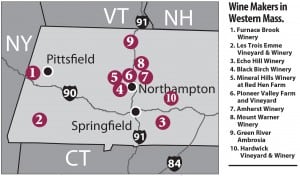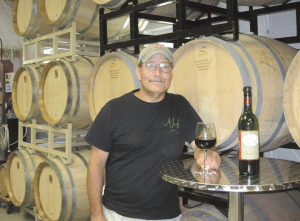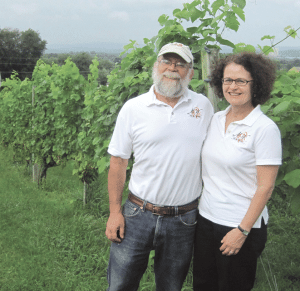
Grape Expectations
Area Vintners Are Seeing the Fruits of Their Labor
Larry Godard acknowledged that he considers them somewhat backhanded compliments. But he loves hearing them anyway.“They’ll taste one and look at me and pause and say, ‘this is really good,’ and they emphasize the ‘really good’ part as if they are surprised at the high quality,” said Godard, referring to comments about the labels, including Red Hen Red, he’s now producing at Mineral Hills Winery at the Red Hen Farm in Florence.
Elaborating, he said that many of the growing number of visitors to Mineral Hills are from Connecticut and New York. They are wine connoisseurs, and they’ve been to many small wineries across the Northeast. But Western Mass. is a relatively new destination for many of them, and this is one of the reasons behind many of those ‘really good’ comments.
And Godard’s not the only one hearing them.
Indeed, he is the sole proprietor of one of a growing number of what could be called start-up vineyards and wineries across the Valley, including Black Birch Winery down the road in Southampton, Amherst Winery in Amherst, Mount Warner Winery in Hadley (which overlooks the UMass Amherst campus), Pioneer Valley Vineyard in Hatfield, Les Trois Emme Vineyard & Winery in New Marlboro in the Berkshires, and several others.They are all part of something called the Massachusetts Wine & Cheese Trail, overseen by the Mass. Farm Wineries and Growers Assoc. (MFWGA), to which Godard belongs, but could eventually comprise a separate wine trail in the four western counties.
In the meantime, Godard and others like him — individuals with a passion for wine and the means and the inclination to go into business making and selling it — are creating what could be described as a community of vintners, and a close-knit one at that.
“A wine trail is already happening by default,” Godard said, explaining that he’ll send his guests to Black Birch and Amherst Winery, and they will in turn send their visitors along to the other wineries in the area. “We have a nice little cluster right here. In fact, Ian Modestow [partner with Black Birch Winery] came over one day to borrow a cup of yeast, like a neighbor borrowing a cup of sugar.”
Mary Hamel, a partner with Black Birch Winery, also noted the fellowship among the region’s wine makers. “That’s one thing about the wine industry that I think is very cool,” she noted. “You don’t feel like you’re in competition with anyone because we support each other, and the more wineries there are, the better it is for all of us.”
More wineries would seem to be a likelihood in every state because demand is growing, and there are many aging Baby Boomers eyeing wine making as a bridge to full-time retirement. According to the 2012-13 “State of the Wine Industry” report by Silicon Valley Bank, a California financial institution specializing the U.S. wine industry, Millennials and Baby Boomers are the two largest sectors of wine consumers, and consumption rates are growing most rapidly among Millennials and men.
And while a burgeoning wine trail will help the region’s vintners, an official trail will certainly be a boon to the Greater Springfield Convention & Visitors Bureau (GSCVB).
Michele Goldberg, director of marketing for the GSCVB, told BusinessWest that, while the Connecticut Vineyard and Wine Assoc., with its established wine trail, is a longtime member, Western Mass. wineries fall perfectly into the emerging ‘farm-to-table’ movement in the tourism industry.

Ed and Mary Hamel of Black Birch Winery have doubled their visitation for wine tastings through great word-of-mouth referrals.
For this issue and its focus on tourism, BusinessWest visited with several area vintners to talk about their businesses and their outlook on how wine can become a prominent part of the region’s economy and tourism sector.
Heard It Through the Grapevine
The stories beyond the wineries taking root in the Valley all vary, but there are many common denominators.
They were started, in most cases, by professionals who decided to turn a hobby into a business venture. These entrepreneurs had some struggles getting things both in the ground and off the ground, but they’re now seeing the fruits of their labors — in more ways than one. And they all will inevitably use the phrase ‘an art and a science’ to describe the process of making a fine wine.
Godard, former vice president at MassMutual, with his wife, Susan, a schoolteacher, is a great example of today’s vintner whose passion for making wine became his ‘second-life’ business.
They established their 60-acre Mineral Hills farm in 1984, and for years they had a well-established honor-system farm stand offering apples, blueberries, cider, and honey products from Susan’s bees. Soon their hobby grew to include a variety of flavors of wine made from apples, blueberries, and grapes. It was only after Godard retired from MassMutual in 2009 that he decided to “go pro,” as he called it, and turn the winemaking hobby into a full-time venture, launching Mineral Hills Winery in the fall of 2010. Godard now produces wines from French-American hybrid grapes, but also imports European vinifera grapes from California for his reds.
At Black Birch Winery, two couples share various duties to run one of the newest wineries in the area. Florence dentist Ian Modestow is the vintner, while construction and home-inspection-company owner Ed Hamel manages the two acres of new vineyards, with five more acres soon to be cultivated.
Modestow’s wife, Michelle Kersbergen, and Hamel’s wife, Mary Hamel, both dental hygienists, manage the marketing and outreach, but all four partners pitch in wherever needed.
Because the vineyards at Black Birch were planted in 2010 and are young (they still have about two years of maturity until they can be harvested), the proprietors currently source their grapes from Southeastern Mass. or the Finger Lakes region of New York.
Since June 2012, they’ve doubled their visitation, from 650 tastings to 1,480 this August, with wines priced between $16 and $20.
Hamel was one of the many who put ‘art’ and ‘science’ in the same sentence as she talked about wine making. “That’s why Ian is so good at it, because that’s what dentistry is, too,” she explained. “A dentist has to know the science, but has to be an artist to get your tooth to look exactly as it did before.”
The owners of Mount Warner Winery in Hadley — Gary Kamen, a UMass professor of Kinesiology who is in ‘phased retirement,’ and his wife, Bobbie, a strategic planner with AARP — agreed.
“I think the reason I enjoy grape growing and making wine is because they are both part art and part science, probably because of my science background,” said Gary Kamen. “Each person who gets into this business enters it with a different perspective.”
Like Godard and the partners at Black Birch, the Kamens started growing grapes with six cuttings, or vines, in their field in 2000. Soon they were making wine, and, like Godard, they decided to ‘go pro’ in 2010, opening their winery in June 2012. Now, with 725 vines per acre, they have six wines, including two dessert wines priced between $14 and $20.
Les Trois Emme Winery in New Marlborough, owned and operated by Wayne and Mary Jane Eline, is located just south of Ski Butternut in Great Barrington and minutes from the Norman Rockwell Museum and Tanglewood. While the rural town has a residential population of 1,400, it swells to more than 3,000 with tourists and second-home residents from New York.
Wayne Eline is a former chemistry teacher and high-school principal who, like Godard, took his hobby to a whole new level after retirement in 1999. The Elines set their first vines in the dirt in 2000, and by 2003, they were open for business.
“If you’re going to get into it, you’ve got to make it into a real business, rather than just playing games. It didn’t take long to go from where it was to where it is now,” he said, adding that he has tripled his yield over the past decade due to “getting really earnest” about the business in 2009.
The venture now produces 11 to 13 wines, with Stingy Jack Pumpkin, a white wine with a fusion of pumpkin spices, emerging as the most popular.
Age-old Tradition
Godard described wine tasting as a very personal experience — for both the taster and the winemaker — and something he’s getting used to as visitation numbers continue to climb.
But he admits that some comments, including those spiced with ‘really good,’ leave him amused and often surprised.
He recalled one visitor from California who commented, “your wines aren’t like our wines,” to which Godard jokingly replied, “that’s like saying your chicken isn’t like our duck.”
The difference, he said, is between French hybrid grapes that grow best in the Northeast, and European vinifera grapes that area vintners source from California, and the two very different climates in which they grow.
“Our wines are different, and they [people from California] should have learned their lesson, because they were treated the same way by the French until the French had their eyes opened when the California wines started taking gold medals at international wine competitions. And that’s happening here now.”
All four wineries have won awards regionally for their wines, and this is perhaps one reason why they’re seeing and meeting a number of avid wine lovers from Connecticut, venturing past that state’s wine trail.
To help bolster visitation, the MFWGA has been promoting the annual Massachusetts Wine Passport Program, which offers a $2 passport to 15 participating wineries in the state. Once the visitor has all 15 unique passport codes from each winery, they are eligible to enter a drawing to win a cellar full of Massachusetts wine.
For Goldberg and the GSCVB, anything that promotes regional ‘buy-local’ efforts is beneficial, and a Western Mass. wine trail would certainly help bring more people to the western counties.
“Eventually, having a number of successful wineries could lead to a Pioneer Valley Wine Trail, wine festivals, and harvest festivals,” she noted.
 A number of wineries already feature their labels at area farmers’ markets, thanks to the Massachusetts Farm Winery Bill, backed by the MFWGA, which allows vintners in the Commonwealth to sell their wine at such venues.
A number of wineries already feature their labels at area farmers’ markets, thanks to the Massachusetts Farm Winery Bill, backed by the MFWGA, which allows vintners in the Commonwealth to sell their wine at such venues.
Keeping with the theme, the Kamens’ philosophy is to make wine only from grapes and fruit that they grow.
“We intend to make a Massachusetts product out of a Pioneer Valley product.” he said, adding that his winery regularly attends the Amherst and the South Hadley farmers’ markets, while Hamel said Black Birch Winery has seen definite growth and awareness of their wines through their appearances at the Northampton Farmers’ Market.
Juicy Futures
Just this summer, the Wine Marketing Council, working with the Nielsen Co., released its annual statistics regarding the global wine market, and found that Baby Boomers spend the most on wine, but with more than 15,000 Millennials coming of age per day, a new target market is emerging. Bobbie Kamen is definitely seeing more young people at Mount Warner Winery.
“Millennials are very eager to try a lot of different things; it’s an exploration for them,” she said. “And if they like it, they’ll buy it.”
Hamel said Black Birch also sees a number of Millennials, which she considers somewhat surprising, but very promising for the future. “On our Facebook likes, the Millennials age group is the biggest,” she said, adding that, while they may not yet have the disposable incomes that Baby Boomers do, they appreciate fine wine and are establishing themselves as solid customers for decades to come.
While advertising will be important, trust in the valued word-of-mouth endorsement will become even more important to this younger generation in learning about the next new thing in wine.
“Word of mouth is really important for us no matter what age, because, yes, we’re in the business of wine,” Hamel stated, “but we’re also in the business of giving people a great experience.”
And at the moment, this is a business laden with potential — not only to spur economic development and jobs, but also to provide a big boost to a host of efforts to put Western Mass. on the map for many different types of visitors.
In other words, when it comes to wine and wineries, the region’s producers have grape expectations.
Elizabeth Taras can be reached at [email protected]







